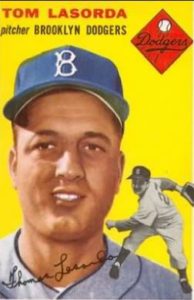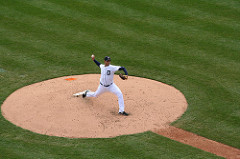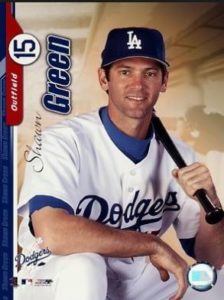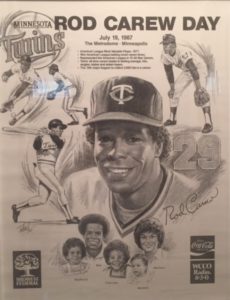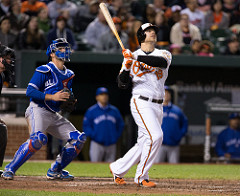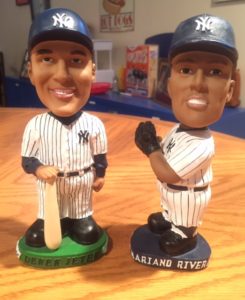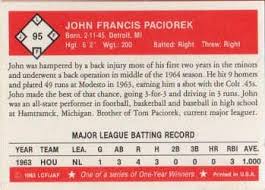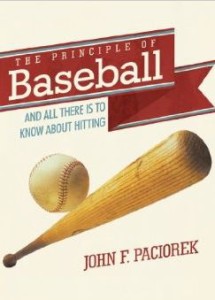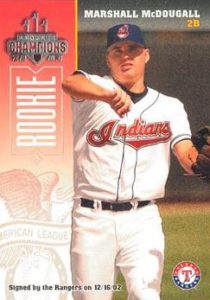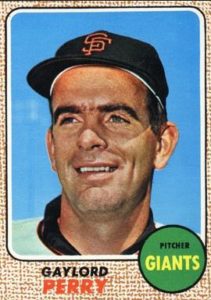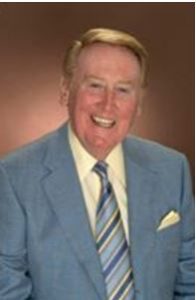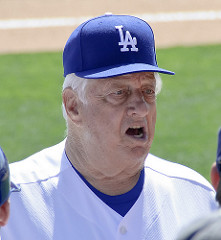
Photo by SD Dirk 
First let me send get well wishes to Hall of Fame Dodgers’ manager Tommy Lasorda ... now recovering aty home after hsi recent pacemaker replacement.
Today seems an appropriate day to look at Lasorda’s (continuing) baseball career, since it was on this date (May 31) in 1948 that Lasorda – then a 20-year-old southpaw in the Phillies’ system – set a new profesional record for strkeouts in a game (25).
TOMMY LASORDA SETS PRO BASEBALL STRIKEOUT RECORD
In a game on May 31, 1948, 20-year-old Tommy Lasorda took the mound for the Schenectady Blue Jays as they faced off against the Amsterdam Rugmakers of the Class C Can-Am League. The youthful southpaw made history that day – fanning 25 Rugmaker hitters in a 15-inning complete-game victory. Lasorda gave up 10 hits, 12 walks, one hit batter and five runs over the course of the game (pitch count estimated at just shy of 300). Oh, and he also drove in the winning run with a walk-off single. Lasorda held the record for strikeouts in a single professional game until 1952, when Ron Necciai fanned 27 hitters in a nine-inning contest. Read about that one here.
A 5’10, 175-pound lefty, Lasorda did make it to the major league mound – 26 appearances for the Brooklyn Dodgers and Kansas City Athletics between 1954 and 1956. And, he got there the hard way. As John Houseman would say “He earned it.” (Now, that’s a reference that dates me. Check the Academy Award winner’s Smith Barney commercials.)
While Lasorda’s major league record was 0-4, 6.48, with 56 walks and 37 strikeouts in 58 1/3 innings, his minor league performance earned him true prospect status.
In 14 minor league season, Lasorda went 136-104 overall – and 110-63 in 11 seasons at Triple A.
A few Lasorda minor league pitching factoids:
- He pitched in 14 minor league seasons – eleven at Triple A.
- His toiled in the Philies, Dodgers, Athletics and Yankees systems.
- His best season was with the Triple A Montreal Royals (Dodgers) in 1958 (at age 30), when he went 18-6, with a 2.50 ERA – and was voted the International League’s Most Valuable Pitcher.
- In a three-start stretch for the Schenectady Blue Jays of the Can-Am League (late May-early June 1948), Lasorda fanned 53 batters.
- Lasorda also played winter ball in Cuba 1950-52 and 1958-60, with his best effort being 8-3, 1.89 in the 1958-59 season.
- At Triple A, he also logged seasons of 17-8, 2.81 (1953); 14-5, 3.51 (1954); 14-5, 3.66 (1952) – all with Montreal. His career record with Montreal is 107-57.
- His professional baseball career was interrupted by a two-year stint in the military (1946-47).
Heart and Soul of the Dodgers
While Lasorda made his major league debut as a pitcher for the Brooklyn Dodgers, he was made to manage the Los Angeles Dodgers. In all or parts of 21 seasons managing the team, he not only proved himself a winner on the ball field, but also proved he could more than hold his own in a city that treasured entertainment and celebrity.
Lasorda’s managerial career was one of tirades (reporters and umpires come to mind), tackles (the Phillie Phanatic) and tumbles (after being hit by Vlad Guerrero’s flying broken bat while coaching third base during the 2001 All Star Game). It was also a career in which he became friends – and held his own –with celebrities from Frank Sinatra to Ronald Reagan to Muhammad Ali.
When Vin Scully retired, much was made of his role as the “voice” of the Dodgers. If Scully is the Dodgers voice, Lasorda is the team’s heart and soul.
Baseball Roundtable
And, it has been a career in which Lasorda (who still holds a position in the Dodgers’ front office) – in his own words – “bled Dodge Blue.” As the Dodgers’ Manager (1976-96), Lasorda rang up 1,599 wins (1,439 losses); two world Championships (four World Series appearances); seven NL West titles; and two NL Manager of the year Awards (1983 and 1988).
There are three types of baseball players. Thos who make it happen, those who watch it happen and those who wonder what happened.
Tommy Lasorda
The fact is, Lasorda was successful as a manager at every level. After he retired as a player, Lasorda began his career with the Dodgers as a scout (1961-65). In 1966, he got his first managerial assignment with the Rookie League Pocatello Chiefs, before moving on to the Ogden Dodgers – a team he led to the Pioneer League title in 1966-67-68. In 1969, it was a move up to a managerial post with the Triple A Spokane Indians and Albuquerque Dukes (the transferred Spokane team), where he led the team to the Pacific Coast League title in two of four seasons (1970 and 1972) and never finished lower than third. In eight seasons as a minor league manager, Lasorda went 501-347, won five league championships and never finished lower than third place.
I walk into a clubhouse today and it’s like walking into the Mayo Clinic. We have four doctors, three therpists and five trainers. Back when I broke in, we had one trainer who carried a bottle of rubbing alchohol – and by the seventh inning, he’d already drunk it.
Tommy Lasorda
In 1973, Lasorda moved up to the big league club, as third base coach for manager Walter Alston – becoming manager when Alston retired in September of 1976. The rest, as they say is Hall of Fame-worthy history. Note: Since retiring as manager in 1996, Lasorda has served in number of executive capacities (Senior Vice President, Special Advisor) with the Dodger Organization.
CONSISTENCY IS … A HALL MARK OF TOMMY LASORDA
In a March 2, 2017 LA Times column, Bill Plaschke pointed out that Tommy Lasorda has spent 68 of his 89 years as part of the Dodger organization; 67 years married to wife Jo; and 65 years living in the same Fullerton, California home. Add to that the fact that in his minor and major league managerial career (32 seasons), his team finished first 40.6 percent of the time and first or second 65.6 percent of the time – and you have a record of consisent loyalty and excellence.
Tommy Lasorda is a member of the Baseball Hall of Fame, International League Hall of Fame, Canadian Baseball Hall of Fame and Pacific Coast League Hall of Fame.
Follow/Like Baseball Roundtable’s Facebook page, click here. More baseball news, notificaiton of new blog posts and great giveaweays.
I tweet baseball @DavidBBRT
Member: Society for American Baseball Research (SABR); The Baseball Relilquary; The Negro Leagues Baseball Museum; Baseball Bloggers Alliance.
